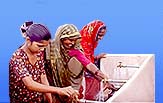/topics/drinking-and-other-domestic-uses
Drinking and other Domestic Uses
UNICEF is looking for 'Communication for Development Specialist' - New Delhi
Posted on 10 May, 2011 01:17 PM
The United Nations Children’s Fund (UNICEF), the world’s leading organization working for the rights of children, invites applications for the following position.
Under the daily supervision of the WASH Specialist, and in consultation with the Communication for Development (C4D) section, the incumbent is responsible to provide strategic guidance, technical inputs and design and production oversight for UNICEF’s WASH communication interventions in child environment programme and for supporting the Ministry of Rural Development, Department of Drinking Water Supply’s relevant behavioural change programmes and initiatives.
Groundwater: From mystery to management - An article by TN Narasimhan
Posted on 22 Apr, 2011 12:07 PMGroundwater has been used for domestic and irrigation needs from time immemorial. It is a component of the hydrological cycle, vital for human sustenance. Unlike surface water, groundwater cannot be readily observed. Consequently, it was long considered to be mysterious or even occult in nature, influencing legal decisions relating to groundwater ownership and use.
Guidance manual for drinking water quality monitoring and assessment - A document by NEERI and NICD
Posted on 20 Apr, 2011 03:09 AMIn order to safeguard the health of the people, drinking water must meet quality standards. The main issues involved in drinking water safety are water quality management, surveillance and control mechanisms.
Levels of contaminants need to be ascertained through standard procedures. Each agency involved in water supply in India, has its own laboratory test practices and this manual details methods for all parameters adoptable by all laboratories.
Water safety plan: A manual for pilot study areas of Hyderabad
Posted on 20 Apr, 2011 02:03 AMThe most effective means of consistently ensuring the safety of drinking water supply is through the use of a comprehensive risk assessment and management approach, that encompasses all steps in water supply from catchment to consumer. Such approaches are called Water Safety Plans (WSPs).
The aim of a WSP is to organize and systematize records of management practices applied to drinking water and to ensure workability of such practices to organized drinking water supply.
Application of Composite Correction Program for improvement in efficiency of water treatment plants - A WHO paper
Posted on 20 Apr, 2011 12:41 AMThe goal of safe and affordable drinking water and sanitation has not yet been achieved. The current practices of water purification are inadequate to produce secured water supply. Maintaining health protection at water supply systems has become more challenging with resistance of some pathogens to disinfection using chlorination and an increase in the immuno-compromised population (e.g., people with HIV, organ transplant patients, the elderly).
In this context, it has become essential to develop various tools such as Composite Correction Programme (CCP) and Water Safety Plans (WSP) to improve water purification and distribution systems, to achieve the goal of providing safe drinking water.
Assessing acute Gastroenteritis risks associated with water quality and sanitation in Hyderabad city - A paper by the Institute of Health Systems (IHS)
Posted on 19 Apr, 2011 11:35 PMThe quality of drinking water is a vital element of public health and well-being. The most effective means of consistently ensuring the safety of a drinking-water supply is through the use of a comprehensive risk assessment and risk management approach that encompasses all steps in water supply from catchment to consumer.
WHO guidelines on water quality term these approaches as water safety plans (WSPs), developed to organize, systematize and apply management practices in drinking-water quality.
Dam cost Rs. 1 crore but village in Dantewada, Chattisgarh depends on dying hand pump ! - An audio update from CGNet Swara
Posted on 18 Apr, 2011 01:28 PMHe gives example of a village near Dantewada where Public Health department has made a check dam spending Rs 1 crore.
Bhisti community in Kolkata usurped by taps - A film from Video Volunteers
Posted on 18 Apr, 2011 12:15 PM
Operation and maintenance for rural water supplies – A manual by Department of Drinking Water and Sanitation and the Water and Sanitation Program of World Bank
Posted on 17 Apr, 2011 07:23 AM This Operation and Maintenance (O&M) manual for rural water supplies by the Department of Drinking Water And Sanitation and Water and Sanitation Program of the World Bank complements their Gram Panchayat Handbook released in 2010 . It takes into account the current aspirations and challenges facing the sector, and builds on the framework already set out in the National Rajiv Gandhi Drinking Water Programme (NRDWP) and Strategic Plan 2011-2022.
This Operation and Maintenance (O&M) manual for rural water supplies by the Department of Drinking Water And Sanitation and Water and Sanitation Program of the World Bank complements their Gram Panchayat Handbook released in 2010 . It takes into account the current aspirations and challenges facing the sector, and builds on the framework already set out in the National Rajiv Gandhi Drinking Water Programme (NRDWP) and Strategic Plan 2011-2022.
“Reddy” remedies - A look at the Satwant Reddy Committee report on the issue of pesticide residues in packaged drinking water and packaged natural mineral water - Article from Down to Earth magazine
Posted on 14 Apr, 2011 10:28 AMSatwant Reddy committee: Report of the committee on the pesticide residue in packaged drinking water and packaged natural mineral water.
Setting standards





